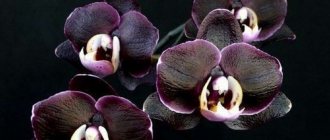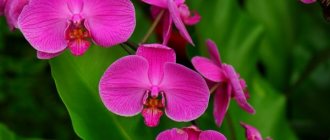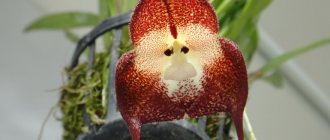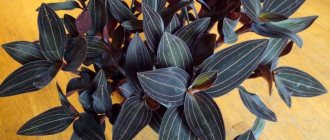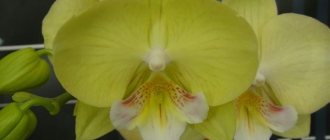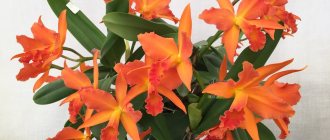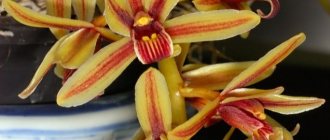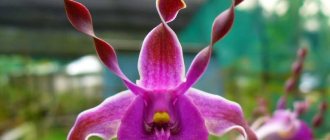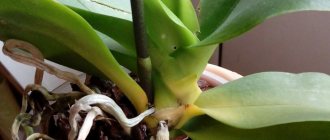Characteristic
Biologists do not have a consensus on whether plants with black petals occur in nature. Many are sure that no, and similar orchids were obtained through selection.
The genus Phalaenopsis can surprise with unusual colors
In fact, if you look closely, you will see that Phalaenopsis black is actually dark purple, maroon or dark blue. This type includes different varieties.
Black bird
The plant is not tall, about 40 cm. The flowers themselves are small, up to 4 cm in diameter. The color is rich blueberry, almost black.
Note! Flowering duration is 8 months.
Black Prince
The most beautiful representative. It has the darkest petals, which have a white core. The diameter of the flowers is 7 cm, the length of the peduncle is up to 50 cm. The leaves of this species are almost invisible.
The Phalaenopsis Prince variety will be appreciated by true connoisseurs of orchids. The number of flowers on one stem depends on the care of the plant and the conditions of its maintenance. If they are properly organized, the plant will bloom profusely.
Black Pearl
The leaves of the variety are almost emerald green, and the number of flowers on one stem reaches four. The petals are purple-burgundy.
Black phalaenopsis orchid Black Pearl looks very impressive
Black Widow
The inflorescences are small, they are collected on a peduncle of 3-4 pieces. The petals are a rich dark blue that looks like black.
Possible varieties with yellow colors
Breeding work has made it possible to obtain a huge number of hybrids and varieties with yellow flowers, which differ from each other in shades, bright color spots or specks:
- Lemon orchids:
- Lycasta fragrant;
- Phalaenopsis Antura golden;
- Dendrobium Lindley.
- Phalaenopsis Wild Peach (Pink with yellow specks);
- Phalaenopsis Harlequin.
- Cattleya Potinara Burana Beauty;
- Cymbidium aloefolia;
- Phalaenopsis Charmer.
- Phalaenopsis Cleopatra;
- Phalaenopsis Amalfi.
- Dendrobium Anna Green;
- Cattleya hybrid Mem Anant;
- And the Helen-Brown Meme.
And these are just some of the representatives of these tropical plants; in fact, there are hundreds of hybrids and varieties.
Landing
Phalaenopsis orchid - home care
The black orchid had a magical effect on many.
For your information! T. Ford was so captivated by the unusual plant that he named a new perfume in its honor. The film of the same name is also popular.
Tom Ford perfume never loses its relevance. Therefore, many people are looking for the plant that inspired him to create a composition. But for an orchid to bloom, special conditions are needed.
Planting is carried out in loose soil. To do this, mix crushed dry bark, coal, sphagnum, and peat. All components are taken in equal parts.
The pot should be 1-2 cm larger than the root system. A container that is too spacious is not needed, otherwise the plant will begin to actively develop green mass.
How to plant an orchid?
It is necessary to follow all the rules for planting a plant so that it takes root normally and feels good. It depends on this whether the crop will bloom and how abundantly. It is worth taking a closer look at all the features of planting an orchid.
Choosing a substrate and pot
You need to approach this choice very responsibly. There are several requirements when choosing a pot:
- it must be transparent;
- a drainage system is required;
- You shouldn’t take a container for growing - it must be the optimal size so that the flower stands in it normally and does not fall;
- It is recommended to choose plastic pots.
The soil must contain the following substances:
- large bark;
- sphagnum moss;
- coconut fiber;
- coal.
Landing algorithm
Planting this variety of orchid is easy. It is only necessary to perform operations in a certain sequence:
- first you need to disinfect the pot;
- then place a drainage layer in it;
- then you need to pour the prepared mixture into the container;
- plant an orchid;
- Sprinkle the roots with a little soil on top.
Watering
Blue orchid - description, varieties, care
Phalaenopsis orchids need moist soil. Therefore, in summer the pot is watered 2-3 times a week. It is advisable to plant the plant in a transparent container, this will allow you to observe the condition of the roots.
Important! If the roots turn green, this indicates a lack of moisture.
You can use the tray irrigation method. To do this, place the pot in a bowl of warm water and leave for 20 minutes. Afterwards, the orchid is pulled out and excess moisture is allowed to drain.
How to choose in the store?
A purposeful or spontaneous trip to a flower shop for a blue orchid and the euphoria from it should not prevent you from choosing the right standard.
After all, sometimes they try to deceive us, passing off a cheap analogue as an expensive thing. This is also possible with flowers. The expensive Phalaenopsis Royal Blue can be replaced with a cheaper analogue of our own production. Orchids are sometimes colored by the sellers themselves, using regular blue ink.
The procedure is performed using a syringe; the orchid is simply pricked with a color carrier. But not every plant can tolerate such manipulations.
When choosing phalaenopsis with blue flowers in the store, you should pay attention to the following points:
before making a purchase, pay attention to the appearance of the trunk; its leaves and roots should have a natural color; the solution to be painted should be applied precisely to the peduncle, so the plant will suffer the least amount of damage; carefully inspect the substrate, it should also have a natural color;
In addition, you can lightly run your fingers over the petal; the paint should not remain on your hands.
Important! It is worth understanding that blue phalaenopsis will require more careful care, since coloring and changing its “place of residence” will already become a great stress for it.
Reproduction methods
The easiest way to propagate is by dividing the bush. When transplanting, the pseudobulbs are carefully separated and placed in different pots. The black orchid also reproduces by cuttings. To do this, select flower stalks after flowering.
Ludisia orchid: main types and home care options
They have dormant buds. It is with them that you need to cut off a section of the stem. After which the cuttings are planted in the ground and covered with a glass jar.
Note! Orchids also reproduce by seeds, but this is impossible to do in an apartment.
Features of care
Phalaenopsis yellow is considered not a picky plant. It quickly adapts to changing environments; the temperature, light and humidity of city apartments suit it.
For Phalaenopsis you should purchase:
- transparent pot;
- special substrate;
- special fertilizer for orchids.
Suitable soil for growing orchids consists of pine bark, sphagnum peat and charcoal. After flowering, the peduncle will begin to dry out, but there is no need to cut it off immediately. Drying slowly, it releases the remaining nutrients to the plant.
If the peduncle remains green and produces new buds, it does not need to be cut. Soon the plant will bloom again. The peduncle is cut at a distance of 1 cm above the dormant bud, around which wet moss is applied. This will stimulate the appearance of a new outlet.
We invite you to watch a video about the secrets of growing Phalaenopsis orchids:
Transfer
You can replant the orchid only after flowering has ended. To do this, carefully remove the plant from the pot.
During transplantation, you need to act carefully, as the roots are easily damaged.
The roots are inspected and damaged parts are removed. Afterwards, the orchid is planted in a new pot, which is then placed in a dark place for 3-4 days. This is necessary for the plant to rest and cope with stress.
Note! Orchid flowers have an unusual shape. They are very sensitive to changes in living conditions, so replanting cannot be done during the flowering period. It is only needed once every 2-3 years, since the bark in the ground has a long service life.
Phalaenopsis black prince photo
The black orchid is one of the most mysterious and unusual representatives of the world of exotic plants. There is still fierce debate about the origin and even the very existence of this flower. Some people believe that the black orchid does not exist in nature at all. What is actually known about this amazing flower?
Does a flower exist in nature?
According to biologists, the color black does not exist in nature in the form in which it is familiar to humans. The shade closest to black is provided by special pigments, which can be violet, dark purple, or blue.
Therefore, phalaenopsis supposedly black in color is in fact usually dark burgundy, dark purple and even dark blue. Visually, such a plant looks black, but the difference can only be noticed upon closer examination of its petals.
Since initially the difference from black in such shades is not very noticeable, the black orchid received this name.
Varieties
Currently, breeders have managed to develop many varieties of black phalaenopsis. It is noteworthy that orchids of such unusual colors in the wild prefer the same living conditions as their counterparts of ordinary colors. The best for them is a humid and warm tropical climate, which ensures massive flowering of plants and their active development.
The most popular varieties of black phalaenopsis are:
- "Black Prince";
- "Black Bird";
- "Black Swan";
- "Black Pearl";
- "Black Mamba".
Let us describe the varieties in more detail.
- “Black Prince” is a phalaenopsis considered the blackest of all existing ones. In fact, the unusual color of this flower is a deep purple, almost inky hue. A characteristic feature of this variety of phalaenopsis is the intricate white markings located in the center of the flower. The height of the plant can vary from 45 to 50 centimeters. The diameter of the flower can reach 7 centimeters. The number of flowers on the peduncle of this phalaenopsis may vary, depending on the characteristics and conditions of detention.
- “Black Bird” is a variety of orchid characterized by very spectacular and long-lasting flowering. The true color of the flowers is deep blueberry. The flowers are large, with an attractive waxy gloss, located on one peduncle.
- “Black Swan” is a very elegant phalaenopsis with flowers of an original shape. The narrow and elongated petals of this orchid are painted in deep purple and have a yellow core with a lilac tongue. A characteristic feature of this plant is its unpretentiousness to growing conditions.
- “Black Pearl” is a hybrid orchid obtained as a result of many years of work by breeders. During the flowering period, the plant forms up to 4 peduncles, on which unusually shaped flowers bloom. The color of the flowers of this phalaenopsis is violet-burgundy, which, in combination with the emerald hue of the leaves, makes the plant very impressive.
- “Black Mamba” is an incredibly beautiful phalaenopsis with deep blueberry-colored flowers and a white center. During the flowering period, this orchid forms one peduncle, on which about 10 buds can form.
- Black phalaenopsis come in more than just ink and blueberry colors. For example, the flowers of the Black Trevor are distinguished by a rich purple-burgundy hue, standing out effectively against the background of dark green leaves.
Optimal conditions of detention
Exotic black phalaenopsis need conditions that are as close as possible to their natural habitat. For normal development and abundant flowering, they need moisture, sun and warmth, that is, conditions similar to a tropical environment.
When growing orchids, it is very important to provide them with the required temperature conditions. The most suitable temperature range is considered to be within 18-22°.
Maintaining the temperature at the specified level will stimulate abundant and long-lasting flowering of plants.
If the air temperature in the room where the orchids grow is inconsistent, then the phalaenopsis simply will not bloom.
No less important for phalaenopsis is moisture, which must be present both in the substrate and in the air.
These tropical flowers do not tolerate moisture deficiency well, during which they begin to form buds less frequently and in smaller quantities. However, excess moisture can be no less harmful for these exotics.
An excessively waterlogged substrate can lead to rotting of the roots and, as a result, the death of plants.
Gardeners consider the optimal level of air humidity when growing orchids to be 30-40%.
If the air in the room is too dry, the leaves of the plants will begin to wrinkle, losing their juiciness and natural turgor. To prevent this from happening, phalaenopsis should be regularly sprayed with a spray bottle.
A wide bowl of water located near the pots will also provide the plants with moisture.
Source: https://obzorteka.ru/ogorod/falenopsis-chernyj-princ-foto.html
Pests and diseases
Various plants, even with good care, can be affected by parasites. But some pests appear only with improper care. If the level of humidity is insufficient, orchids are affected by spider mites. It can be easily identified by the cobwebs on the leaves.
Thrips can be easily identified by the larvae on the plant.
Sometimes aphids appear on orchids. It can be detected during a routine examination; these are small green insects. To get rid of these pests, use a soap solution. To do this, dissolve 100 g of laundry soap in 1 liter of warm water. The mixture is sprayed onto the plants.
An excess of moisture is dangerous, as is its lack. When overwatered, root rot develops, which can destroy the plant. It can be identified because the roots turn black and gray spots appear on the leaves. For treatment, the plant is replanted, the affected areas are removed and treated with fungicides.
Another sign of waterlogged soil is the appearance of black spots on the foliage. If this symptom occurs, you need to remove the diseased parts of the plant and stop watering for the time being.
Basic growing rules
- Drafts, as well as direct sunlight, are very dangerous for the flower. Therefore, the ideal place for an orchid is a well-lit area without direct sunlight. In summer, it is better to take the flower outside, but in winter, the temperature indoors should be maintained at least 14 °C.
- Any heaters are detrimental to the crop, as they dry out the air and negatively affect the health of the flower.
- The soil can be prepared with your own hands or purchased ready-made, which includes pine bark, peat, moss and other components.
So, there are different types of orchids. However, today black flowers are especially popular among gardeners. With proper care, such crops will delight you with their flowering and beauty for a long time.
Black butterfly
On the long peduncle of Phalaenopsis Butterfly there are clusters of medium-sized flowers of a thick wine shade with small light speckles , their petals resemble the wings of a fluttering butterfly, which gives the plant an airy, light exotic look.
Flowering period
During flowering, all plants are very sensitive to the environment. Therefore, during this period it is necessary to organize good care. Descriptions of varieties do not always give a complete picture of the beauty of certain specimens.
The approximate air temperature should be 22 °C and humidity 40%. To do this, the plant is not only watered abundantly, but also sprayed regularly.
Note! There is a little trick: you can place a bowl of water next to the pots. The moisture will evaporate and humidify the air.
The room with orchids is ventilated once a day. A constant supply of oxygen is important to improve flowering.
Orchids need long daylight hours. To do this, they are placed on the windowsill or illuminated with phytolamps. An orchid needs 12 hours of light per day. It can exude an unobtrusive floral aroma.
Black phalaenopsis is rarely found in collections, but such flowers are very unusual and beautiful. Not only Tom Ford was captivated by this plant. Such flowers can become the pearl of anyone’s home composition.
Growing and planting black orchid flowers, varieties: Prince, Birdie, Widow, care
Orchids are popular ornamental plants. At the same time, it is a very delicate plant that requires special care to remain healthy. Black orchids are very rare in homes and therefore arouse undoubted interest.
Characteristics of black orchid
With regard to indoor floriculture, the Phalaenopsis genus is the most common of the Orchidaceae family. Their popularity is due to the fact that representatives of the genus are quite easy to care for. This genus has about fifty different species, all of tropical origin. Phalaenopsis orchids grow in exotic countries such as Taiwan, the Philippines and Australia.
Orchids are never completely black
The black orchid is an original flower. However, there is not much true black in nature. In fact, this shade is provided by special blue or purple pigments. Phalaenopsis black up close turns out to be dark burgundy or dark purple. But these flowers are still beautiful.
It is not surprising that Tom Ford created his famous perfume “Black Orchid” based on the smell of black orchid. Ford's Orchid is not even a fragrance, but a step towards bohemian luxury. It is worth noting that plants can have different shades. For example, Phalaenopsis variety Black Pearl may have pinkish-red, burgundy or dark purple petals.
Common varieties and varieties
Phalaenopsis orchid: main types and home care options
Even the so-called black orchids exist in several varieties and varieties.
Orchid Black Pearl
They differ in appearance and sometimes are completely different from each other. The most popular ones are presented below.
It has a rich blueberry hue. The flowers are located on one peduncle, they are large, with a waxy gloss. Flowering is very spectacular and long lasting.
It has an almost inky tint. A characteristic feature is white spots in the center.
It can reach a height of up to 50 cm, the diameter of the flower is no more than 7 cm.
For reference! The number of colors Black prince has depends on the conditions of detention.
This black phalaenopsis orchid is the fruit of careful selection. Its flowers have a very unusual shape; the plant forms up to 4 peduncles. The color is burgundy with a slight purple tint, the leaves are a rich emerald color.
A very attractive plant. The shade is very juicy, colorful, and you just want to touch the petals. The black orchid flower has an elegant shape.
- Not the most famous varieties of black orchid
Black Trevor, Black Mamba and Black Swan orchids are quite interesting varieties.
Orchid Black Trevor
They all need proper care, without which they will not be as attractive.
Planting a plant
Phalaenopsis propagation at home: examples by children and cuttings
General tips and advice for caring for orchids apply to most plants on the market.
These impressive flowers require basic care that is not that difficult.
However, you need to know their specific preferences, such as amount of watering, required lighting, temperature, type of environment, etc.
Planting in a pot
Phalaenopsis orchids really need light, so you need to find a suitable place for proper flowering. For this reason, it is advisable to place them next to a window or terrace, but without direct rays. The ideal temperature should be around +22 ºC during the day and between +16 ºC and +20 ºC at night.
A plastic pot is usually a good choice because when it comes time to repot the plant, the plastic is much easier to separate and can even be cut off without problems to remove the roots as carefully as possible if necessary.
Attention! You cannot use regular garden soil for potted orchids.
Pre-made substrates are available from nurseries and garden centers and are usually made from cork, white peat, charcoal, vermiculite, polystyrene and coir. What all these materials have in common is that they are spongy, lightweight and resistant, capable of storing water and nutrients, maintaining optimal conditions for caring for orchid roots.
Watering
Orchid care at home: options for propagating and planting a flower
Watering is probably one of the most delicate aspects of orchid care. The water should be soft enough to almost completely eliminate tap water, which usually contains diluted salts. They concentrate in the substrate and roots of plants, disrupting their growth and flowering.
Watering the plant
Any description of the watering procedure says that it is advisable to use rainwater. But this is quite difficult, because few people will be able to collect and store water every time it rains.
As a substitute, you can use bottled water with a low content of mineral salts, sodium, and calcium. Orchids usually do not need much water to bloom.
Water should only be applied when the surface of the soil is almost dry. Therefore, you should do this about twice a week in spring and summer, during the hottest months; and once every two weeks in winter and autumn. During the period from March to October, it is advisable to add a small amount of special fertilizers to the water.
To water properly, follow these instructions:
- Orchids prefer a moderately moist substrate because if it is too wet, the roots cannot breathe and will rot.
- It is best to leave the substrate dry, watering it a day later. Therefore, the frequency of watering will depend on the ambient temperature.
- You can tell if the plant needs water if the substrate is dry to the touch or if the roots are whitish. If they are green, then no watering is needed.
- Watering should be plentiful, but without flooding the roots.
- The water should be at room temperature.
You should try not to wet the flowers to avoid stains. It is also necessary to avoid getting water on the surface of the leaves.
Attention! The orchid needs a high level of humidity, ranging from 60 to 80%.
Reproduction methods
Orchids can be propagated in two ways: cuttings or seeds.
Reproduction methods
Important! There is an opinion that to grow an orchid you can simply pick a leaf. Gardeners who talk about this method are actually mistaken - most likely, they accidentally tore off the leaf along with part of the trunk where the dormant buds were.
Unlike violets, leaves alone are not enough to grow orchids.
Reproduction through cuttings ensures that the new plant has the same genetic characteristics as its parent. The samples raised through seeds are not identical. Some species of the genus Dendrobium and Phalaenopsis themselves form small new plants.
Aerial roots emerge from the stem. When the roots reach a size of 3 to 4 centimeters, the new plant is separated, the wounds are healed with coal dust and placed in a pot.
Feeding and fertilizers
Providing nutrients to orchids is a good way to encourage natural growth and new blooms. Orchids should be fertilized during the growing season.
Feeding and fertilizers
As with watering, it is better to apply less fertilizer than more. Epiphytic plants have very few nutrients in their natural habitat.
Transplanting a plant
Epiphytic orchids rarely need a larger pot, however, it is important to refresh the substrate from time to time so that the roots breathe well and can dry evenly.
It is recommended to replant your orchid every two to three years, regardless of the condition. It is also important to pay attention to the types of orchid pots. If there are a lot of roots or they extend beyond the edge of the pot, then the plant definitely needs to replace the container. You also need to change the substrate if traces of fungi or rot are visible.
Before you start replanting, you need to make a small drainage (pebbles or polystyrene), the flower pot itself needs to be cleaned and disinfected.
Procedure for transplantation:
- To remove the plant, you need to press your hand on the surface of the pot to disconnect the roots. Then hit the base.
- Completely remove the old backing.
- Use disinfected scissors to cut off any dead roots.
- Disinfect wounds with coal dust or cinnamon.
After this, phalaenopsis can be planted in a new container on fresh soil.
Black orchid pruning
Any organic debris, such as leaves or fallen flowers, should be removed as soon as possible to prevent rotting. Large cuts or wounds should be healed. To close the wound, the incisions should be sprinkled with coal dust or cinnamon.
Pests and diseases
Orchids need fresh air; care must be taken to ensure that the room in which they are located has minimal daily ventilation, but is not exposed to cold winter air.
Affected leaves
Air renewal is necessary in order to avoid the appearance of certain types of diseases, mainly caused by fungi.
Attention! High concentrations of moisture combined with high temperatures and polluted air provide ideal soil for the proliferation of fungi, bacteria and viruses.
The most common pests are snails and slugs, especially if orchids are in the garden. If any symptoms of disease are noticeable, it is recommended to contact a specialist garden center, where experts in the field can help and recommend remedies.
With proper care, a black orchid can bloom several times a year. In fact, Phalaenopsis orchids will adapt much better to indoor living than to outdoor conditions. And varieties with black flowers arouse constant interest among everyone.
Source: https://pocvetam.ru/komnatnye-rasteniya/orhidei/chernaya-orkhideya.html
Rare varieties of phalaenopsis: Biondoro, Black pearl, Blue, Buddha
Under natural conditions, phalaenopsis grows in Southeast Asia. Has a very diverse range of colors . It can be either soft white or aggressive blue, pale pinkish and bright red.
The so-called “lip” of the flower stands out against the general background, the pattern of which can be striped, mesh or tiger. The shade of the plant and the color of the lip depend on its specific species .
Let's consider special varieties of phalaenopsis: Biondoro, Black pearl, Blue, Buddha.
Immediately appreciate the Phalaenopsis Biondoro in the photo.
Biondoro is a rare orchid with a greatly shortened stem.
Phalaenopsis, as a type of orchid, has up to 70 species. The Biondoro orchid belongs to the monopodial type.
External characteristics and features
It has a greatly shortened stem with wide, dense leaves. An adult plant ready for flowering has from 4 to 6.
The leaves are evergreen, but as they age they turn yellow and die. New ones appear in their place. The leaves are compact, medium in size and oblong in shape.
The peduncle grows long with well-developed axils. Its petals have an elongated oval shape.
Important! The Phalaenopsis biondoro flower, like all orchids, resembles a butterfly.
The buds themselves are large with a variety of shades. From yellow with a purple pattern to plain dark red. The aroma is pleasant, pronounced.
The appearance of the peduncle and its branching directly depends on the quality care of the flower.
The stem slowly but constantly grows upward and reaches a length of up to 45 cm.
One of the subspecies of this species is biondoro multiflora:
- It has oblong, ovoid leaves , bright green in color;
- Their size is 35-40 cm , quantity - on average 4 pieces;
- Flower up to 6 cm in diameter;
- The inflorescences themselves are large, blooming on a branched long peduncle;
- Number of flowers up to 15 on one brush;
- The sepals are cream or red interspersed with different shades.
Watch the video for an example of a healthy Biondoro orchid:
A little about black orchids
The following colors of orchids are familiar to us
- White,
- purple,
- orange,
- Reds.
The black tint of the flower causes considerable surprise .
Important! There is no pigment in nature that gives black color to a plant. Through breeding work in California, a black variety of orchid, Phalaenopsis black, was bred.
The black orchid is very popular among Hollywood stars. (Not Black Pearl pictured)
Characteristics and features
The black flower is particularly beautiful and is popular among famous Hollywood artists .
A plant with such a shade has also attracted the interest of experienced gardeners . After all, it is known that in nature there is no necessary pigment for flowers to have a black tint.
Orchid Black Pearl
Phalaenopsis Black Pearl has a fascinating effect on orchid lovers and has a magnetism unique to it.
Bloom
For full flowering, the plant must be provided with diffused light without direct sunlight and placed in a warm place.
When the room temperature drops below 16 degrees and there is a lack of light, the buds begin to fall off .
Advice! In autumn, in order for flower buds to form, the plant should be kept at a temperature of about 16 degrees, but not lower, for 1-2 months.
Orchid Black Pearl.
An air temperature of 22-24 degrees is considered comfortable .
Subspecies of phalaenopsis with the word Black in the name :
- Black butterfly,Black butterfly.
- Black treasure,
- Black prince, Black prince.
- Black velvet,Black Velvet.
- Black mambo, Black Mamba.
- Black pearl.Black pearl.
They have flowers of dark burgundy and dark blue shades , which is why they are called black orchids.
The Black Butterfly orchid has fairly large inflorescences, the bud size is 7 cm. They have a pronounced dark burgundy hue.
The black orchid, developed by plant breeders in California, has a scent reminiscent of vanilla .
presentation of the orchid - Phalaenopsis Black Pearl:
This species is shrouded in many rumors and speculations. Indeed, some gardeners sell the Phalaenopsis Royal Blue orchid variety, passing it off as blue . But in fact, it is a standard plant with painted white buds .
Are there blue orchids in nature? On orchid growing forums you can find information that there are varieties of Cattleya in natural blue color. This is roughly what they look like (photo taken from an interesting video about these beautiful flowers https://www..com/watch?v=y1W0cGt9DqM):
Blue Cattleya.
Distinctive features
Under natural conditions, orchids do not have the pigment that gives their flowers their blue color . Such a bright blue hue as that of the Blue variety, which is sold by some gardeners, cannot be achieved .
There are wild orchids with pale blue, lilac, pink-blue tints of blossoming buds.
Although these unsaturated colors are very rare for phalaenopsis and concern some plants with small flowers.
The technology of coloring standard white phalaenopsis blue appeared back in 2009 almost simultaneously in South Florida (USA) and in the south of Holland, as a result of long experiments and experiments, and spread almost throughout the world.
In nature, phalaenopsis does not have blue pigment. In most cases it is artificial paint.
The dyeing process itself and the type of dye are hidden from consumers. In a nutshell, it is described as follows: phalaenopsis with white flowers are placed in chambers with a specially created environment from natural elements.
As a result, the blossoming buds acquire a blue tint using a method that is safe for the plant.
Important! Manufacturers in the characteristics of the Blue variety warn that further flowers will be white.
Watering and coloring plants at home
Phalaenopsis Blue will retain the blue color of the buds until the end of flowering . This period can be extended by watering it correctly.
The orchid should not be watered often - once a week is enough. In this matter, you must adhere to one rule - water after the substrate in the pot has completely dried.
The frequency of watering is mainly affected by:
- Indoor air humidity,
- The quality of the substrate in the pot,
- Pot volume.
At home, it is better not to paint so as not to destroy the plant.
As for the subspecies of Phalaenopsis Blue, the most common of them is Royal Blue :
- It has fleshy dark green leaves in the amount of 4-6 pieces;
- The buds bloom gradually on long curved peduncles, ensuring a long flowering period for the plant;
- The difference between the Aida Blue species is its love for placement in a bright place ;
- It should be watered by immersing the pot in water for a while;
- The Belina Blue variety occurs in nature with flowers of a delicate blue-violet hue;
- The number of leaves is from three to seven. They grow 25 cm in length and have pointed ends;
- Peduncle size – 15 cm.
Buddha
Buddha Orchid, flower photo.
Phalaenopsis of this species have one difference - the long life of the peduncle . It constantly grows from the apical bud after a period of dormancy.
Characteristics and distinctive features
On the peduncle of the Buddha variety, the number of blossoming buds is small. The plant, as it were, saves the energy accumulated for the constant flowering of the orchid. With a significant number of buds, the peduncle can quickly elongate, which is unacceptable for this variety.
The diameter of the Buddha bud is from 6 to 9 cm. The shape is round with five symmetrical ovoid petals.
Since the number of flowers is small, the peduncle should be short . After all, a long bare peduncle with several buds at the end would not look entirely aesthetically pleasing.
The distance from the leaves to the first blossoming bud is only 10 cm. See the decorative phalaenopsis buddha, flowering photo below.
In Buddha, the distance from the leaves to the first blossoming bud is only 10 cm.
Features of flowering
The limited number of flowers is compensated by the constant growth of new peduncles on which the buds ripen:
- Orchids of this species have the property of growing new flower stalks when the old ones have not yet dried out;
- For the Buddha variety, the possibility of branching the peduncle . This leads to an increase in the number of flowers;
- This variety belongs to the miniature variety. Its diameter together with leaves is 15-20 cm ;
- A characteristic feature is a very short peduncle . Therefore, such a plant does not look very attractive in a standard orchid pot;
- It is better to keep it in an epiphytic culture ;
- “Buddha” blooms quite quickly , but the flowers themselves are not as lush and beautiful as those of standard varieties.
Against the general background, this variety stands out with a short peduncle and is perceived as some kind of unique exotic specimen of an orchid.
Buddha orchid review:
These varieties watered sparingly throughout the year, especially in winter.
It is necessary that the roots have time to dry before the next watering. If you do not follow this rule, the plant may lose its roots from rotting and may also contract a fungus .
More important than watering and fertilizing is high air humidity in the room where they are kept.
Conditions of detention
They must be kept in bright areas of the windowsill or in the back of the room with good lighting. Comfortable temperature for a flower is +20-25°C.
Advice! During the period of stimulating flowering, a temperature difference should be ensured (4-5 degrees between day and night).
Air humidity should be at least 40 percent.
Disease Prevention
Preventive measures to combat diseases include proper care:
- Protection from direct sunlight. They can burn the tender leaves of the orchid;
- Protecting the flower from excessive moisture caused by frequent watering;
- Avoiding hypothermia.
The orchid is susceptible to both low temperatures and steaming. If she remains in such conditions for more than 11 hours, she will die.
The whole truth about blue orchids on video:
Useful tips
Elevated temperatures and excessive humidity negatively affect the condition of orchids . It is necessary to ventilate the room more often , do not place them close to each other.
should not be allowed to remain on the peduncle and leaves for a long time.
Source: https://komnatnie.com/orhid/phal/sortaf/redkies/biondoro-black-pearl-blyu-budda.html
